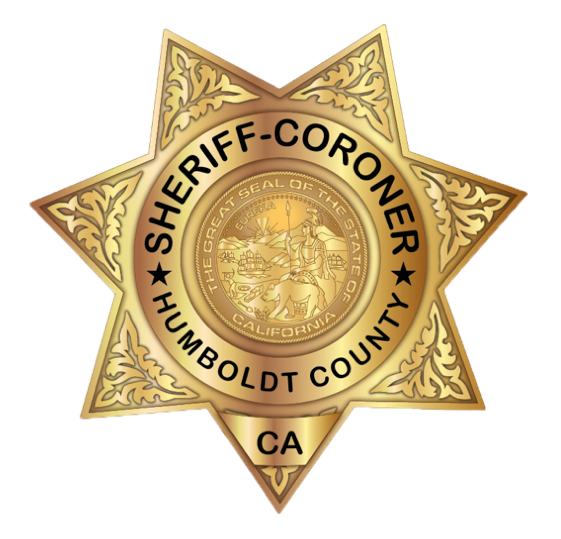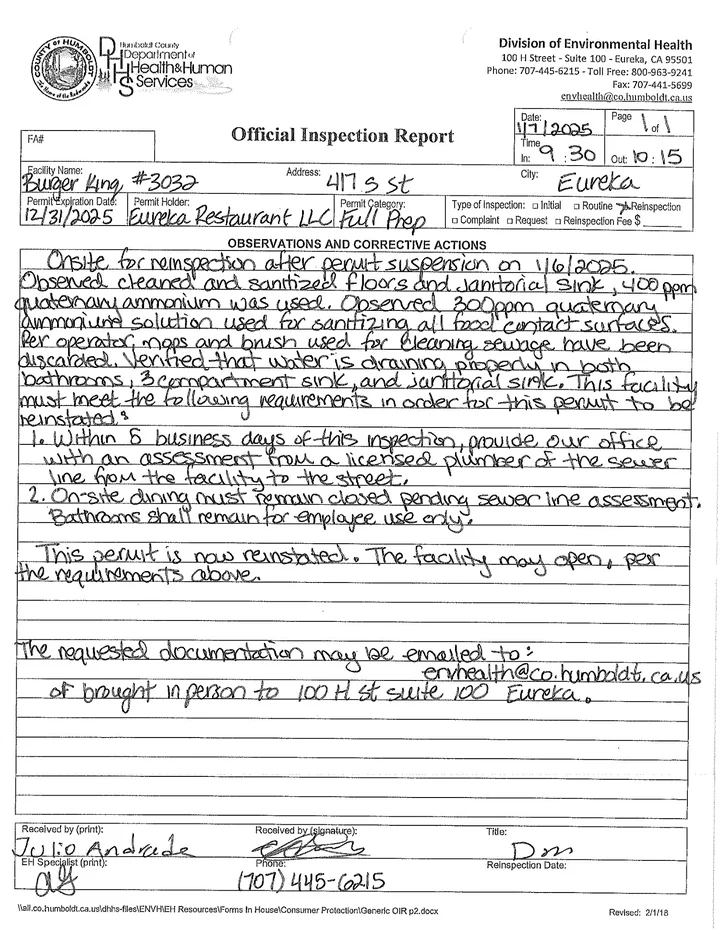TODAY in SUPES: With Some Apprehension, Board OKs Potential Path to Legitimacy for Yee Haw Communal Living Property
Ryan Burns / Tuesday, Jan. 7, 2025 @ 4:30 p.m. / Local Government
The Humboldt County Board of Supervisors (from left): Natalie Arroyo, Mike Wilson, Michelle Bushnell, Steve Madrone and Rex Bohn. | Screenshot.
###
How do you solve a problem like Yee Haw?
For years now — and especially in recent months — county officials have been grappling with the ethical, legal and public health implications of the “intentional community” near Trinidad, where some two dozen low-income residents live in un-permitted makeshift dwellings replete with violations of county code — as is the 10-acre property on which they sit.
Back in September, the Board of Supervisors gave property owner Charles Garth 39 weeks (until late June of this year) to fix the code violations at 473 Quarry Road or else the county would proceed with tenant eviction and abatement measures, including environmental cleanup as well as demolition and removal of un-permitted structures.
At today’s meeting of county supervisors, staff with the Planning and Building Department reported that Garth and his tenants have made progress on addressing many of the public health concerns onsite, and Garth has submitted a petition that, if approved, could provide a pathway to making Yee Haw a fully permitted “Alternative Lodge Park.”
Granted, there’s a long way to go before that could happen, with perhaps $100,000 worth of technical studies and permitting fees required on top of property renovations to meet health and building codes and comply with the Americans with Disabilities Act, plus tens of thousands of dollars in unpaid fines.
Senior Planner Steve Lazar explained that while Garth applied for a general plan amendment and zone reclassification, staff believe the best path forward would instead be to amend the Tiny House Village provisions of the county’s zoning ordinance so this property could legally accommodate its multiple residences.
Lazar noted that two portable toilets and a hand-washing station have been installed on the property, as requested, and testing of the onsite water well revealed no bacteria.
“I think it’s safe to say that they’re acting in good faith to work towards compliance with these public health directives,” Lazar said, “but there remains work to be done.”
Garth was on hand to address the board, though he didn’t have much to say.
“This isn’t our first dance,” he said. “Me and the county have been doing this for quite a while. … You haven’t shut me down yet because we keep taking steps forward [and] you keep taking steps forward.”
He said he appreciates the work that county staff has done toward finding an alternative to eviction and abatement.
Fifth District Supervisor Steve Madrone has worked closely with Garth and the Yee Haw residents, and in public meetings he has been a staunch advocate for finding a way to accommodate the community, even if it requires bending or rewriting some rules.
But his fellow supervisors proved a bit more wary, especially First District Supervisor Rex Bohn and (today, at least) Third District Supervisor Mike Wilson.
Bohn said he worried that changing the zoning ordinance as requested — allowing emergency housing villages on land zoned for agriculture — could open the door to other developments of this kind all around the county. He also voiced skepticism about Garth’s ability and willingness to bring his property up to code by the deadline. Bohn also said that some of the junk vehicles that have been removed from Yee Haw were dumped in his district, near Loleta.
“So the problem didn’t go away; the problem got moved,” he said.
Madrone thanked staff for their work and said he’d be happy to change some rules.
“Does this open the door [for similar low-income communities]? Yeah, thank goodness, because we have a housing problem,” he said.
Madrone, who has a long history of advocating for composting privies, also suggested modifying the county’s waterless toilet ordinance. He failed to get traction with that request.
Wilson voiced concerns about “spot zoning” and the parcel’s access to public services such as sewer, water, public transit and fire protection.
Second District Supervisor Michelle Bushnell, whose one-year term as board chair began with today’s meeting, said she was worried about establishing a double standard. Garth’s petition asks the county to make an exception to its typical requirements for a Category Four road, and Bushnell noted that local weed growers have typically not been afforded such leeway.
During the public comment period, nearly all of the speakers voiced support for the Yee Haw community and the county’s efforts to accommodate it, though several of the speakers were residents.
When the supervisors resumed their deliberations, Wilson said he remains concerned about the long-term sustainability of this community given Garth’s track record and his status as a private landowner. He suggested possibly establishing a nonprofit so that residents could take advantage of grant funding.
Wilson also noted that changing the land use of the parcel from timberland to residential estates would significantly increase Garth’s property value while potentially opening the door to future subdivision of the property into four 2.5-acre estates with two residences apiece.
Eventually, despite these reservations, the board unanimously approved a motion to accept staff’s recommendation, thereby creating the path to legitimacy for Garth and his property. However, the motion, which was made by Madrone, included a provision to require Garth to pay close to $40,000 to reimburse county staff for its work on code enforcement at the property.
Airport hangar rent increase
Early in the meeting, during the public comment period for non-agenda items, several local pilots stepped to the lectern to voice concerns about recent airplane hangar rent increases at all county airports, a fee hike that some found galling given the sorry state of maintenance at the facilities.
One pilot said the rent increase forced the Northern Air Flight School/fixed-base operation (FBO) to close, though he and volunteers are working to revive it. Another complained that his hangar doors haven’t worked for years, and yet he was recently sent a bill for $2,000 in back rent.
“I feel like you guys are trying to kill general aviation,” pilot Dan Sayer said. “We’re not rich. We’re just trying to make it. We need a little service.”
Bushnell encouraged the pilots to send emails to the board, as that would make follow-up easier.
No paid holiday to mourn President Carter
Late in the meeting, prior to adjourning closed session to discuss legal matters, the board weighed whether or not to grant employees a paid day off to mourn the Dec. 29 death of former U.S. President Jimmy Carter.
Chair Bushnell, perhaps responding to some public side-eye about the proposal, took pains to note that it wasn’t her idea! She sponsored the agenda item as board chair but did not personally have a preference either way, she said.
County Administrative Officer Elishia Hayes said there’s some precedent for taking such a paid day of mourning: The county took one after former President George H.W. Bush died in 2018, for example. Plus, the current president called for this national day of mourning, she said.
“From my perspective, it’s either something that we do consistently or we don’t do at all, and I’m okay with making that decision today,” Supervisor Wilson said.
A couple of the supervisors noted that the county doesn’t exactly have money to burn at present, and the board ultimately decided not to give employees Thursday off with pay, though if they truly need that time to grieve they’ll be allowed to use some of their accrued paid time off, or take the day off without pay.
BOOKED
Today: 5 felonies, 11 misdemeanors, 1 infractions
JUDGED
Humboldt County Superior Court Calendar: Today
CHP REPORTS
Shelter Cove Rd / Toth Rd (HM office): Car Fire
ELSEWHERE
Governor’s Office: Governor Newsom issues proclamation declaring 2026 statewide primary election date
Governor’s Office: Governor Newsom issues statement on Trump administration’s vaccine schedule endangering the lives of infants and children
Governor’s Office: One year after Los Angeles firestorms, California continues all-of-government community recovery efforts
RHBB: Road Conditions Update from Humboldt County Public Works
Arcata Man Arrested for Attempted Homicide Following Truck-Ramming, Hatchet Attack Incidents Last Week, Eureka Police Say
LoCO Staff / Tuesday, Jan. 7, 2025 @ 4:18 p.m. / Crime
Press release from the Eureka Police Department:
On 01/04/2025 at approximately 1853 hours, an Officer with the Eureka Police Department observed a large pickup truck eastbound on 5th street following a small blue Subaru sedan.
The driver of the truck repeatedly rammed the Subaru causing it to swerve across all lanes of 5th street for several blocks, and eventually crashed the vehicle into the parking lot of the Red Lion Pub. This resulted in the victim of the Subaru receiving injuries to his face/head and exiting his vehicle claiming the person was trying to kill him. The victim advised the Officer that the suspect had been following him for several miles and continued to ram his vehicle.
The suspect was placed in custody and the vehicle was cleared. During the search of the vehicle, officers noted what appeared to be a hatchet or tomahawk on the rear floorboard. Both the vehicle and weapon matched the description of what was reported during an assault on 01/03/25. The vehicle was towed from the scene for evidence pending a search warrant related to the following investigation.
On 01/03/2025 at approximately 2343 hours, a male victim was standing in front of a business in the 600 Block of W. Harris, when he was attacked and struck several times on the head and upper body by a male suspect with a hatchet. The victim escaped into the parking lot, was briefly chased by the suspect, who then stopped. The victim went to a residence across the street and asked for help.
Officers arrived on scene as the victim was being transported by ambulance to St. Joseph Hospital. The witnesses told officers that the suspect in the assault drove past the residence honking his horn and yelling at them and provided identifying information for the vehicle.
The suspect in both of the above incidents was identified as Carl Stover (42 years old), from Arcata. Stover was arrested and booked into at the Humboldt County Correctional Facility for Attempted Homicide, Reckless Driving and Assault with a Deadly Weapon.
Would You Like to Help Watch Over College of the Redwoods’ New $120 Million in Bond Authorizations? Apply Now!
LoCO Staff / Tuesday, Jan. 7, 2025 @ 2:29 p.m. / Education
File photo: CR.
Press release from College of the Redwoods:
In the November election, College of the Redwoods successfully secured voter approval for Measure I, authorizing up to $120 million in general obligation bonds to support local educational infrastructure improvements. Measure I was passed under the guidelines of Prop 39, which requires financial accountability and the formation of an Independent Citizens’ Bond Oversight Committee.
In compliance with these requirements, CR’s Board of Trustees has officially established the oversight committee, tasked with ensuring transparency and proper use of bond funds to enhance district facilities. The committee was approved by the CR Board of Trustees at a public meeting on January 7th, 2025.
The Committee will play a key role in ensuring transparency and accountability in the use of bond revenues. According to Administrative Procedure (AP) 6740, the committee’s primary purpose is to:
- Inform the public about the expenditure of bond revenues;
- Review and report on the proper expenditure of taxpayers’ money for school construction; and
- Advise the public as to the District’s compliance with the Proposition 39 requirements as contained in the California Constitution
Members of the Citizens’ Bond Oversight Committee may engage in the following activities:
- Receive and review copies of the annual, independent financial audit;
- Inspect school facilities and grounds to ensure that bond revenues were properly expended;
- Receive and review copies of any deferred maintenance proposals or plans developed by the District; and
- Review efforts by the District to maximize bond revenues by implementing cost-saving measures.
The committee will have at least seven members, each serving two-year terms, with a maximum of three consecutive terms. Members won’t be paid but can be reimbursed for reasonable travel costs following CR’s travel policies. To be on the committee, members must meet certain criteria:
- One member must be involved in a local business organization.
- One member must be part of a senior citizen group.
- One member must belong to a recognized taxpayer organization.
- One member must be a current CR student who is active in a campus group. The student can continue serving for up to six months after graduation.
- One member must be engaged in supporting or organizing activities for the college.
Interested individuals can visit the CR website at this link to submit an application or learn more about the committee’s responsibilities.
Applications will be reviewed starting January 31st, 2025.
Eureka Man Arrested After Leading Law Enforcement on Wild Goose Chase Up and Down the Samoa Peninsula
LoCO Staff / Tuesday, Jan. 7, 2025 @ 11:59 a.m. / Crime
Press release from the Humboldt County Sheriff’s Office:
On Jan. 5, 2025, at around 10 a.m., a Humboldt County Sheriff’s deputy on patrol in the area of the Samoa Dunes Recreation Area observed a parked vehicle with expired registration and contacted the two adults who were sitting near the vehicle.
A male, later identified as Joshua Price, 44, of Eureka, falsely identified himself to the deputy as “Billy Waters” and asked to use the restroom, but instead he fled on foot into the nearby dunes. A records check on Price revealed that he had a felony arrest warrant stemming from a December 2024 violation of HS 11370.1(A): Possession of a Controlled Substance While Armed.
Deputies searched the area for Price. Deputies located some of his personal items but were unable to locate Price at the time.
Around 12 p.m., a deputy observed Price walking northbound on the beach near the Bay. Upon the deputy attempting contact, Price began sprinting and then entered private property at the Humboldt Bay Social Club, violating Penal Code 602 (trespassing).
Price was ultimately located in a wooded area of Samoa and, with assistance from a Game Warden, he was taken into custody without further incident. Price was transported and booked into the Humboldt County Correctional Facility for his outstanding warrant.
Anyone with information about this case or related criminal activity is encouraged to call the Humboldt County Sheriff’s Office at (707) 445-7251 or the Sheriff’s Office Crime Tip line at (707) 268-2539.
After a Bit of a Delay, Humboldt’s New Solar Energy Producer in Kern County is Now Operational
Hank Sims / Tuesday, Jan. 7, 2025 @ 11:09 a.m. / Energy
Sandrini at sunset. PHoto: EDP Renewables.
PREVIOUSLY:
###
It took a couple of years longer than expected, but a big new solar farm outside Bakersfield is now pumping electrons into the grid, and is providing for about a third of the total electrical needs of customers of the Redwood Coast Energy Authority.
“RCEA has been phenomenal to work with, and we’re really happy to get them closer to their goals,” said Tom Weirich, the head of marketing and stakeholder relations at EDP Renewables, in a quick conversation with the Outpost this morning. EDP is the developer of the Sandrini Solar Park, the solar farm in question.
Sandrini actually became operational sometime last month, Weirich said, but everything is looking good and they made the big announcement this morning.
Press release from EDP Renewables, via the Redwood Coast Energy Authority:
EDP Renewables North America LLC (EDPR NA), a leading renewable energy developer and a top-five renewable energy owner and operator in the United States, unveiled Sandrini I & II Solar Energy Park (Sandrini I & II) today in Kern County.
The two-phase solar energy park includes the 200 megawatt (MW) Sandrini I, which has a 15-year power purchase agreement (PPA) with Shell Energy North America (SENA), and 100 MW Sandrini II, which has a 15-year PPA with Redwood Coast Energy Authority (RCEA). Both phases of the project were commissioned in Q4, 2024.
Generating enough energy to power the equivalent of more than 76,000 California homes each year, Sandrini I has already disbursed more than $510,000 in tax payments to local governments since 2023. This has strengthened the local community by enhancing schools, roads, and other essential services. Additionally, approximately $15 million will be paid to local landowners, who lease a portion of their land to house the solar energy park’s infrastructure. Sandrini I & II employed more than 200 workers during construction and will create several permanent operations positions.
Power from Sandrini II will provide over a third of the total annual electric need for customers of RCEA’s community choice energy program. RCEA supplies more than 90% of the electricity for Humboldt County on California’s rural north coast. Completion of Sandrini II marks a large step toward RCEA meeting its goal of supplying 100% renewable energy to its customers by 2030.
RCEA is one of 25 community choice aggregators (CCAs) now serving communities in California. Sandrini II adds to 8,000 MW of new clean energy resources brought online to date by California’s CCAs. An additional 10,000 MW of new clean resources are in contract with these CCAs and are currently under development or construction. The CCAs’ clean energy projects collectively support over 36,000 construction jobs across California and the West.
“RCEA is committed to achieving our goal of supplying Humboldt County with 100% renewable energy. Sandrini II is a welcomed addition to our energy portfolio. We are proud to see another high-impact solar project go to work on behalf of our community,” RCEA Board Chair Sarah Schaefer said.
The construction and ongoing operations of Sandrini I & II will continue to aid in local spending and support of small businesses - namely restaurants, hotels, and retailers - located near the project. Both phases of the solar energy park also yield environmental benefits, including saving more than 381 million gallons of water each year compared to the amount of water that conventional generation sourceswould need to produce the same amount of capacity. These water savings, in turn, will help aid Kern County’s water conservation goals.
“Sandrini I & II represent EDP Renewables’ continued commitment to investing in California and are a direct contribution to California’s admirable target of achieving 100 percent clean electricity by 2045,” added Sandhya Ganapathy, CEO of EDP Renewables North America. “The Golden State is known for its leadership in solar energy, and EDP Renewables is elated to meet the growing demand for reliable, clean energy sources.”
EDPR NA is a clean energy leader in California, currently operating six renewable energy projects in the State, totalling 488 MW of capacity. Its projects include three phases of the Rising Tree Wind Farm, two phases of the Lone Valley Solar Park, and the Windhub A Solar Park. EDPR NA’s California portfolio also boasts several other solar parks and battery storage facilities, including the recently completed 200 MW solar and 40 MW storage Scarlet Solar Energy Park.
###
About EDP Renewables North America
EDP Renewables North America LLC (EDPR NA), its affiliates, and its subsidiaries develop, construct, own, and operate wind farms, solar parks, and energy storage systems throughout North America. Headquartered in Houston, with 61 wind farms, 19 solar parks, and eight regional offices across North America, EDPR NA has developed more than 11,700 megawatts (MW) and operates more than 10,500 MW of onshore utility-scale renewable energy projects. With more than 1,000 employees, EDPR NA’s highly qualified team has a proven capacity to execute projects across the continent. For more information, visit the website and follow us on LinkedIn.
About RCEA
Established in 2003, the Redwood Coast Energy Authority is a local government joint powers agency whose members include the Blue Lake Rancheria, Yurok Tribe, the County of Humboldt, the seven cities within the county, and the Humboldt Bay Municipal Water District. RCEA’s purpose is to develop and implement sustainable energy initiatives that reduce energy demand, increase energy efficiency, and advance the use of clean, efficient, and renewable resources available in the region. For more info, visit the website.
BK is BACK! The Eureka Burger King is Operational for the Time Being, But Only the Drive-Thru Part of it For Now
LoCO Staff / Tuesday, Jan. 7, 2025 @ 10:55 a.m. / Health
PREVIOUSLY:
Good news from the corner of Fifth and S streets: The floors of the Eureka Burger King have been sterilized and they’re serving customers again.
But don’t expect to encounter the bitties in the the BK lounge proper anytime soon, as the restaurant is limited to drive-thru services until such time as a longer-term assessment of the site’s sewage infrastructure can be performed.
Once again, here is the handwritten report from the Humboldt County Division of Environmental Health, which likes to keep it retro:
OBITUARY: Ted Ruprecht, 1928-2024
LoCO Staff / Tuesday, Jan. 7, 2025 @ 6:56 a.m. / Obits
Ted
Ruprecht’s Obituary
August 1, 1928 to December 14,
2024
The best life stories are the ones the person writes himself. This is excerpted from an essay our father wrote for his 80th birthday celebration. We celebrated again on his 90th, and he continued having adventures until past his 96th. Here’s what he wrote:
###
I was born to Lorraine Follet & Fredrick Kilian Ruprecht in New York’s Presbyterian Hospital. My grandfather migrated alone from Germany at 16 years old and rose to became head of the Standard Oil maritime division. My mother was the first female Art Director of a New York advertising agency. My father quit college to go to sea on a Standard Oil ship. He became a naval architect.
I grew up in Brooklyn a sickly child, as evidenced by having to repeat the first grade and my memory of taking cod-liver oil and having to sit by the window to absorb sunlight. I remember my first fight on the streets of NY, which I lost. That night my father gave me a boxing lesson and the next day out I went to restore justice with my first fight victory.
Our apartment was next to the baseball field in Prospect Park. My father and I would go up to the roof and watch the games. Thus, was born my enjoyment of baseball. I became a lifetime fan of the Dodgers.
When I was seven, my parents wanted to get me and my sister out of NY and so we moved to Ardsley, a small Italian community about 25 miles north of the city that was settled by Italian workers brought to the US to build the NY Aqueduct.
We lived a few miles from town in the country. I loved it. My activities were gardening with my father, sledding in the winter where you belly-flopped immediately after another kid, sledded faster, reached out, grabbed and jerked his runner and sent him into the snow bank.
Christmas was very important in our family. We never saw the tree until Christmas morning. This was during the Depression, and I found out later that my father waited until Christmas Eve when the trees were cheaper to buy it. I slept very little on Christmas Eve because I knew Santa was going to give me a kiss and I was afraid his beard would tickle me and wake me up and if I woke there would be no Christmas. In the morning, I would lead a family parade through the house and by the tree and presents while singing “O Tannenbaum.”
In about the third grade, I began to notice I couldn’t see the blackboard but I didn’t want to wear glasses, so when we lined up at school for our eye exams, I memorized the eye chart—which worked fine until they asked me to read it backwards.
During the Great Depression, when there was no war on and no need to build more naval ships, my father was laid off. My mom was the primary breadwinner. We moved frequently because we were living in foreclosed houses. Eventually the bank would sell that house, and we’d move to another. By the fifth grade we were in Crestwood, still 25 miles from NY, along the Bronx River where we lived in a 3-story Victorian house with sliding doors, a curved staircase and a tower. I had the entire third floor with my electric trains in the tower. Lots of kids to play with, learned to ride a bike, had my first girlfriend, and put in a big flower garden with my father.
During the summers, we spent a week at a relative’s farm in Vermont who took in visitors to augment their farm income. We kids watched the cows being milked; we slopped the pigs and jumped in the big hay pile in the barn. Thus, was born my desire to live in the country and have animals.
During WWII, my father came out to California to design cargo ships being built in Long Beach. When times seemed safe, he brought the rest of the family west to Long Beach, California, the summer before the seventh grade.
I was painfully shy. Back East in the summer, we wore shorts, but when I did this in California the neighborhood kids made fun of me. The result was I never again went outside to play for the rest of the summer. I gardened and made balsa plane and ship models and miniscule clay ship models.
Despite the sickly childhood, I never had an absent day in Jr. High, mostly because I didn’t know what the process was to return to school after missing a day and was too shy to find out. I remember air-raid warnings and blackouts with our heavy black curtains and boxes of sand to put out the incendiary bombs. In Junior High I did all the athletic activities and got my first exposure to track in the All-City Jr. High track meet. When we tried out for it at school, I ran a sprint but they sent me back to try again because they said I wasn’t trying; they hadn’t seen me straining. I was trying, I just ran relaxed, and I was not yet very fast.
At Woodrow Wilson High School, I went out for track. My father had run middle distance in college and my mother had gotten her nickname Coy from the star university football player noted for his speed. For the first workout, we all lined up to run a quarter mile race. I had no clue, but toward the end I began passing gobs of people so I was entered in the ‘B’ 220 at our first meet. I got second, and the couch came and said, “Give this kid a uniform,” as I had run in my gym clothes.
As a Junior, I won the All-City 440 in probably the most significant race of my life because coming toward the end I was very tired (I was always very tired, always throwing up after each race) and in third place. I remember thinking, “I can just coast in and nobody will ever know,” but I decided not to, to give a final effort in what I now consider a momentous life course decision. As a senior, I was elected captain and ran the sprints, set the school record in the 220, was selected All-City, got second in both sprints, was selected in the So-Cal Interscholastic Federation, placed in the state meet, and had the ego-stroking experience of being recruited for college.
I chose Occidental College (Oxy) mostly due to the guidance of my high school teacher, Vince Reel, who was a graduate from Oxy. He was also a great coach, being selected by the US Dept of State to coach three different countries’ Olympic teams, an important element in my maturation. My Oxy coach was Payton Jordan, himself a great sprinter and later a US Olympic coach. The two most memorable track events of college were first, anchoring the meet that decided the final relay in Oxy’s dual most victory over Stanford University, and second, the four man mile relay in my junior year in the Coliseum Invitational before 40,000 spectators.
Because this was an invitational meet, teams were from all over the US. The favorite, Morgan State, was a black team from the East Coast with three National Collegiate Champions-to-be. We were invited as a sort of local flavor afterthought. In a neck and neck race, Oxy won in the fastest time in the world for that year and the second fastest winning time in history.
I aspired to be a naval architect like my father, but he advised against it. He said it was only a good profession when there was a war on.
While working on my Ph.D in Economics at UC Berkeley, I continued to run. My first year at Berkeley was an Olympic year and I tried to make the Olympic team. I did run my personal best time, and although I didn’t make the team, my time would have qualified me for every other country’s team except Germany.
I had culture shock when I went to large and impersonal Berkeley from little, sheltered Occidental. My appointed advisor was a famous economics theoretician, but I never met him, he was too busy; my advising was done by the secretary.
During my third year, I was the “house mother” in one of the dorms, and I noticed a cute switchboard operator wearing a low-cut dress. I sought her out at the first “mixer” dance. Later, when I got down on both knees and asked her to marry me, Joan Marie Ledgerwood made my life by saying yes.
I left Berkeley to teach at Occidental while I continued to work on my dissertation, “Population Growth and Egyptian Economic Development.” As a graduate student, I published a paper in the prestigious American Economic Review.
We had our first child, Janet, in Los Angeles. When we came to Humboldt State College in 1958, there were only two economists and a student body of 2000. I intended to stay 3-4 years as that was how to play the academic game, but ended up staying 33 years — until retirement.
During this, time we added Carol, Phillip and Elaine to the family and spent considerable time abroad on various leaves.
The was a Fulbright research grant to the Philippines to continue working on the issues of rapid population growth’s impacts on economic development. I had the privilege of working with one of the all-time greatest demographers, Frank Lorimer, who became a mentor and promoter for me. The year spent there was exciting, with terrific collogues, breakthrough research and eventually a book on the subject, as well as collaboration on a Philippine Economics textbook, a number of papers and conference presentations in the Philippines and at the world population conference in Belgrade, Yugoslavia.
Sadly, we lost a second son, Luke, in childbirth in the Philippines.
The Fulbright experience later led to an invitation to be a member of an elite International Labor Organization team to go to the Philippines and prepare a study on Philippine economic development for the government. President Marcos invited the team to breakfast at the palace, where I ate the best mangos I’ve ever tasted.
The family spent 15 months in Paris, France, while I was a consultant to the Organization for Economic Co-operation & Development and its Population Center. All our children went to French school and learned French without previously knowing any at all. Another book was one outcome of this very interesting experience in a large prestigious international organization.
I spent a term as a visiting scholar in the Demography Department of the Australian National University in Canberra. Later, with support from the Population Council in New York, I served for a summer as advisor on population to the Koran Development Institute in Seoul. Where, among other things, I learned to hate kim-chee.
My colleague at HSU, Frank Jewett, and I developed a computer program that allowed us to examine the effect of demographic change at the family economic level in contrast to the common macro economic level. One result of this work was to be invited to contribute a chapter to a book edited by the French demographer, Leon Tabah, for the International Union for the Scientific Study of Population, the leading world organization for population study. Frank Lorimer, one of its past presidents, nominated me for membership and into I was admitted. A second result was an invitation to present some of our findings at an international conference in Tunisia, a paper and discussion of this and others’ papers that had to be done in French. A third result of our work was the publication of the book, The Micro-economics of Demographic Changes.
The final international academic experience was another Fulbright, this time to the Karl Marx Institute of Higher Economics in Sofia, Bulgaria in the Fall of 1992. What made this rather extraordinary was that I was the first western economist after the change from communism to be at this University, which was the elite economics university in the country. I taught in English to the best and most eager students I ever had. In fact, I had teacher’s shock when I got back to HSU due to the contrast and decided to retire.
In Sofia, I enjoyed interviewing the people selling goods in the street market. They were avid entrepreneurs.
During my years at HSU, I gained a reputation as a very hard grader. One of my students famously said, “I worked harder for this C than any other grade I ever got.” Notwithstanding, I was selected HSU’s Outstanding Professor by the student body.
I was careful never to serve as the Economics Department chair, as this was a thankless task. But I did serve as president of ACSCP, the forerunner of the Academic Senate. I retired in 1993, as did Joan.
Years later, a former student, Don Lewis, who had become an economics professor at the University of Wollongong in Australia, honored me by funding a Research Assistanceship at HSU. I remembered him well: he came to office hours to discuss an exam and I asked him his major. He replied, “Athletics.” He wanted to become a football coach. I said, “What a waste.” This casual remark changed the trajectory of his life.
Travel was an important part of our retirement. Joan and I traveled in the Caribbean, cruised from Manous, Brazil, to Senegal, Morocco and the Mediterranean, and around South America from Chile to Argentina, and across the Atlantic to Europe and the Baltic countries, and to 34 ports in the Norwegian fjords. Later we cruised to Mexico, Hawaii, and Alaska.
During the running boom of the 70s, I returned to running locally with the Six Rivers Running Club, and also in the combined running and horseback riding discipline of Ride & Tie where Joan and I, and later my daughter Carol, competed in the world championships—of which I completed 25. Overseas I competed in Australia in the Canberra Times Championship 10 Kilometer and in the Blagoevgrad Half Marathon in Bulgaria. I also competed in Endurance Horseback Riding, which involves long distance, usually 50 miles, cross-country races. I accumulated 12,000 race miles.
The nicest things ever said to me were:
1) yes, I will marry you, by Joan to my proposal,
2) you ride like a 13-year-old girl,
And 3) you passed your Ph.D qualifying examination.
###
Our dad lived another 16 years after writing this. He doesn’t mention his extensive vegetable and flower gardens, for which he is justly famous. Or that he and our mom helped raise their grandson, Louis Ruprecht, and greatly enjoyed their other grandkids, Sara (Howard) Landrum, Jessica Ruprecht, Kate (Ruprecht) Rust, who are now raising the great-grandkids. He also served as a mentor to Robert Yarber, who lived with our family for six years, and Slavena (Savova) Castle, who as a teenager befriended them in Sofia and returned with them to continue her education in the States.
He was active in the Ride & Tie Association, serving as a board member and the treasurer, as well as managing two World Championships in Humboldt County. He also served as a board member and treasurer for the Redwood Empire Endurance Riders.
He was a fierce warrior to protect the greater Trinidad area from development. He was a founder of Save Rural Trinidad and a board member of the ensuing Trinidad Coastal Land Trust. He granted an easement on the Ruprecht Ranch property to the Trust in order to keep it rural forever.
The family would like to express our gratitude to Shelly Luna and Jaime Sumahit, who helped lovingly care for our parents.
Because we held a big birthday celebration in August for both parents, the family is not planning a celebration of life at this time. If you can, please send a memory by email to janet.ruprecht@gmail.com.
If you are so inclined, you may make a donation to the Dr. Ted Ruprecht Research Assistantship in Economics for students involved in research with an Economics faculty member, by choosing Fund ID: A6687 at this link. Or mailing to the Gift Processing Center, Cal Poly Humboldt, 1 Harpst St, Arcata, CA 95521. Please note “In Memory of Ted Ruprecht” in the memo line.
###
The obituary above was submitted on behalf of Ted Ruprecht’s loved ones. The Lost Coast Outpost runs obituaries of Humboldt County residents at no charge. See guidelines here. Email news@lostcoastoutpost.com.








